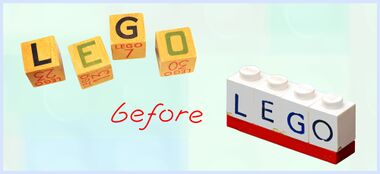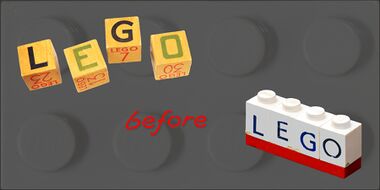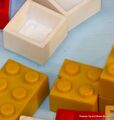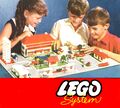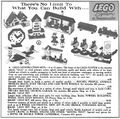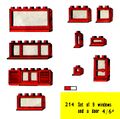Category:Lego before Lego (display)
| Display Area |
|---|
|
 |
| 25 - Lego before Lego (display) Arch Two |
| –– 01 02 03 04 05 06 07 08 09
10 11 12 13 14 15 16 17 18 19 20 21 22 23 24 25 26 27 28 29 30 31 32 33 34 35 36 37 38 39 40 41 42 43 44 45 46 47 48 49 50 51 52 53 54 55 –– 57 58 –– –– 61 62 63 64 65 66 67 –– –– –– 71 72 73 74 –– 76 77 78 79 80 81 82 83 84 85 86 –– –– –– |
2019: Logo [image info]
Lego before Lego, dark logo [image info]
"Lego Before Lego: a secret history" is a special display starting on 29th June 2019 at Brighton Toy and Model Museum.
Based on items drawn from the Hatley Lego Collection, the display features early "pre-Lego" wooden toys made by the Lego company, and some of the earlier and rarer plastic brick sets.
This summer we are very excited to have a new exhibition ‘Lego before Lego’, telling the story of the early days of the Lego Company, from its original wooden toys of the 1930’s-40’s up to the popular plastic toys of the 1960’s - when the building brick sets became an essential part of modern childhood.
It includes original toy shop signage, a variety of different scale vehicles including the classic 1:43 Chevrolet lorries, building blocks, farm vehicles, loveable characters and pull-along toys.
History
1932: Wooden products
Carpenter Ole Kirk Christiansen had originally started a carpentry business in (~1917?) in the hope of selling quality furniture, but business was not good, and by 1932, Ole was sufficiently encouraged by the worldwide craze for wooden yo-yos to start over with a company making wooden toys (and occasional other household goods).
The new company was named LEGO in 1934, after a competition among the company workforce (after which Ole declared his own suggestion to be the winner!) A close runner-up was apparently "Legio". "Lego" was reminiscent of the Danish "leg godt" ("play well"), but given the toy industry's habit of naming companies after anagrams of its founders' names, it may not have been completely coincidental that "LEGO" contained the three letters of Ole's first name. Having a name that was only four letters long also made it easier to stencil the name onto the toys.
1947: Wood and plastic
After WW2, the Lego company decided to buy an injection moulding machine to make some of the more fiddly parts of its wooden toys. This arrived in 1947. At this point, much of Lego's range (apart from the fire engines) reflected what children would see in Denmark's agricultural communities - pull-along animals such as cats, dogs and ducks, trucks, and tractors and farm implements.
The Brick
The sales rep for the injection moulding machine company is supposed to have brought a pocketful of samples of the sort of thing one could use the new machine to make, including some of Hilary Page's clip-together Kiddicraft plastic bricks. Lego started making "LEGO Mursten" (LEGO bricks) that were near-identical clones of the Page slotted bricks.
Lego System and 1961 Town Plan Set
After a sales rep told Lego that chain stores liked "System" toys like Meccano, which had lots of follow-on sales, Lego rebranded its bricks as "Lego System", and produced a Town Plan Set including a baseboard with little cars and trees and street furniture, with simple buildings that could be built from supplied Lego bricks. Once the Town Plan Set had got children used to playing with Lego, small accessory packs let them increase the number and range of pieces in their collections.
1958-1964 redesign and expansion
When Lego started exporting the bricks to more demanding foreign markets like Germany, it was felt that the bricks' design needed improving, and in 1958, Lego removed the slots and chose a design that added cylindrical tubes to the underside of the bricks so that every stud was gripped at at least three points. This was followed by dedicated roofing bricks and wheel/axle bricks in 1962, and dedicated doors and windows in 1964, to produce the "core set" of pieces that we'd regard as "modern Lego".
1959: "Lego" brand means means Lego bricks
By the late 1950s, it had also become clear that the success of the LEGO bricks was making the name "LEGO" synonymous with the bricks, so the company took all their other products (wooden/plastic lorries and wooden construction sets) and rebranded them as BILOfix in 1959. After a factory fire in 1960, Lego decided not to rebuild their wooden toy manufacturing capability, and to make Lego bricks their sole business, with Karl Georg Christiansen and Gerhardt Christiansen then turning the Bilofix brand into a separate company.
From this point onwards, "Lego" effectively became the name of the plastic bricks themselves, which were now just "Lego" with no further explanation needed.
Display area
Area 25 is fittingly flanked by two permanent cabinets of construction toys, including the Hilary Page system that Lego was originally based on.
We've also added an external timeline graphic, a ten-inch fixed tablet displaying a slideshow of Lego and pre-Lego history, and holders for colouring-in sheets and coloured pencils.
Listings:
As of 29th June 2019, the exhibition itself is now complete, with over a hundred exhibits: the online listings here list about half the items.
External links
Subcategories
This category has the following 15 subcategories, out of 15 total.
A
- Lego 1:87 accessories (2 P, 12 F)
- Automatic Binding Bricks - Lego Mursten (Lego) (1 P, 5 F)
B
- BILOfix (2 P, 10 F)
C
- Lego 1:87 cars and other vehicles (1 P, 22 F)
E
H
K
L
- Lego accessory packs (10 P, 32 F)
- Lego System by Samsonite (6 F)
- Lego wheels (3 P, 5 F)
M
- Modern Lego Bricks (Lego) (empty)
S
W
Pages in category ‘Lego before Lego (display)’
The following 48 pages are in this category, out of 48 total.
B
C
F
L
R
S
Media in category ‘Lego before Lego (display)’
The following 111 files are in this category, out of 111 total.
- Angle and Valley Corner Tiles, Lego Set 283 (LegoCat ~1960).jpg 689 × 952; 67 KB
- Base Plates, Lego Set 227 (LegoCat ~1960).jpg 689 × 952; 96 KB
- Base Plates, Lego Set 228 (LegoCat ~1960).jpg 689 × 952; 87 KB
- Base Plates, Lego Set 229 (LegoCat ~1960).jpg 689 × 952; 94 KB
- Bevelled Bricks, Lego Set 280 (LegoCat ~1960).jpg 689 × 952; 56 KB
- Bevelled Bricks, Lego Set 281 (LegoCat ~1960).jpg 689 × 952; 70 KB
- Bevelled Bricks, Lego Set 282 (LegoCat ~1960).jpg 689 × 952; 65 KB
- Breakdown Lorry, Lego 256 (LegoCat ~1960).jpg 689 × 476; 48 KB
- Building Instructions, Lego (LegoCat ~1960).jpg 2,500 × 1,683; 324 KB
- Church Special Box, Lego Set 309 (LegoCat ~1960).jpg 689 × 952; 75 KB
- Corner Bricks, Lego Set 217 (LegoCat ~1960).jpg 689 × 952; 67 KB
- Curved Bricks, Lego Set 224 (LegoCat ~1960).jpg 689 × 952; 59 KB
- Cyclists and Motorcyclists, Lego Set 270 (LegoCat ~1960).jpg 689 × 476; 62 KB
- Double Garage Special Box, Lego Set 306 (LegoCat ~1960).jpg 689 × 952; 84 KB
- E-Type Jaguar in Garage, Lego 670 (Lego ~1964).jpg 702 × 488; 68 KB
- Eight-Stud Bricks, Lego Set 218 (LegoCat ~1960).jpg 689 × 952; 67 KB
- ESSO Lorry, Lego 251 (LegoCat ~1960).jpg 689 × 476; 44 KB
- Esso Petrol Pumps and Sign, Lego Set 231 (Lego ~1964).jpg 702 × 488; 53 KB
- ESSO Petrol Pumps, Lego Set 231 (LegoCat ~1960).jpg 689 × 476; 59 KB
- ESSO Tanker, Lego 250 (LegoCat ~1960).jpg 689 × 476; 51 KB
- ESSO Trailer, Lego 252 (LegoCat ~1960).jpg 689 × 476; 36 KB
- Fifty Lettered Bricks, Lego Set 234 (LegoCat ~1960).jpg 689 × 952; 65 KB
- Fifty Numbered Bricks, Lego Set 237 (LegoCat ~1960).jpg 689 × 952; 67 KB
- Fire Engine with Ladder, Lego 255 (LegoCat ~1960).jpg 689 × 476; 61 KB
- Fire Station Special Box, Lego Set 308 (LegoCat ~1960).jpg 689 × 952; 86 KB
- Ford Taunus in Garage, Lego 263 (Lego ~1964).jpg 702 × 488; 64 KB
- Four-Stud Bricks, Lego Set 220 (LegoCat ~1960).jpg 689 × 952; 59 KB
- Garage Base with Automatic Door, Lego Set 235 (LegoCat ~1960).jpg 689 × 952; 86 KB
- Garage with Automatic Door, Lego Set 236 (LegoCat ~1960).jpg 689 × 952; 77 KB
- Hilary Page patent 633055 01 (1945-1949).jpg 1,225 × 1,933; 320 KB
- Hilary Page patent 633055 02 (1945-1949).jpg 1,227 × 1,897; 217 KB
- Hilary Page patent GB529580 (1939-1940).jpg 1,207 × 2,007; 254 KB
- Hilary Page patent GB587206 (1944-1947).jpg 1,247 × 2,025; 335 KB
- Hilary Page patent GB673857 (1949-1950).jpg 1,399 × 2,200; 460 KB
- Illuminating Brick, Lego Set 245 (LegoCat ~1960).jpg 689 × 952; 67 KB
- International Flags, Lego Set 242 (LegoCat ~1960).jpg 689 × 952; 55 KB
- Karmann Ghia in Garage, Lego 265 (Lego ~1964).jpg 702 × 488; 62 KB
- Kiddicraft and Lego bricks.jpg 675 × 500; 49 KB
- Kiddicraft Self-Locking Building Bricks, assembled house.jpg 1,200 × 900; 670 KB
- Large Base Plate, Lego 700 E (LegoCat ~1960).jpg 1,378 × 952; 134 KB
- Large Wheels, Lego Set 401 (Lego ~1964).jpg 702 × 976; 87 KB
- Large-Size Lego Blocks, Samsonite (Schwarz 1967).jpg 2,739 × 1,247; 459 KB
- Lego Basic Sets (LegoCat ~1960).jpg 1,600 × 1,069; 221 KB
- Lego before Lego, dark logo, 4x2 (2019).jpg 1,200 × 600; 256 KB
- Lego Before Lego, logo, pastel (2019).jpg 2,000 × 916; 166 KB
- Lego Building Instructions (Lego ~1964).jpg 2,000 × 1,349; 296 KB
- Lego logo, stamped on a wooden toy (1930s).jpg 648 × 331; 57 KB
- Lego Mechanical Sets, Samsonite (Schwarz 1967).jpg 2,000 × 1,495; 481 KB
- Lego Screen 010.jpg 800 × 1,278; 120 KB
- Lego Screen 020.jpg 800 × 1,278; 265 KB
- Lego Screen 040.jpg 800 × 1,278; 418 KB
- Lego Screen 050.jpg 800 × 1,278; 332 KB
- Lego Screen 070.jpg 800 × 1,278; 438 KB
- Lego Screen 080.jpg 800 × 1,278; 405 KB
- Lego Screen 100.jpg 800 × 1,278; 464 KB
- Lego Screen 120.jpg 800 × 1,278; 314 KB
- Lego Screen 130.jpg 800 × 1,278; 358 KB
- Lego Screen 140.jpg 800 × 1,278; 336 KB
- Lego Screen 160.jpg 800 × 1,278; 515 KB
- Lego Screen 170.jpg 800 × 1,278; 390 KB
- Lego Screen 180.jpg 800 × 1,278; 488 KB
- Lego Screen 190.jpg 800 × 1,278; 358 KB
- Lego Screen 200.jpg 800 × 1,278; 362 KB
- Lego Screen 210.jpg 800 × 1,278; 340 KB
- Lego Screen 220.jpg 800 × 1,278; 274 KB
- Lego Screen 230.jpg 800 × 1,278; 179 KB
- Lego Second Generation bricks (Lego).jpg 1,515 × 1,600; 194 KB
- Lego Sets (Lego ~1964).jpg 1,600 × 1,089; 230 KB
- Lego System (LegoCat ~1960).jpg 2,099 × 1,882; 586 KB
- Lego System range, Samsonite (Schwarz 1962).jpg 2,200 × 1,458; 549 KB
- Lego System single-sheet catalogue (LegoCat ~1960).jpg 2,500 × 1,264; 618 KB
- Lego System single-sheet catalogue (LegoCat ~1964).jpg 1,600 × 813; 329 KB
- Lego Town Plan Board, Lego 200 (LegoCat ~1960).jpg 699 × 1,162; 132 KB
- Lego Town Plan Set, Samsonite (Schwarz 1962).jpg 1,993 × 1,641; 302 KB
- Little House, Lego Set 211 (LegoCat ~1960).jpg 689 × 476; 54 KB
- Little House, Lego Set 212 (LegoCat ~1960).jpg 689 × 476; 51 KB
- Little House, Lego Set 213 (LegoCat ~1960).jpg 689 × 476; 50 KB
- Little Shop, Lego Set 210 (LegoCat ~1960).jpg 689 × 476; 51 KB
- Mercedes 190SL in Garage, Lego 266 (Lego ~1964).jpg 702 × 488; 64 KB
- Mercedes-Benz in Garage, Lego 264 (Lego ~1964).jpg 702 × 488; 68 KB
- No Limit With Lego, Samsonite (Schwarz 1967).jpg 2,000 × 1,985; 650 KB
- Opel Rekord in Garage, Lego 262 (Lego ~1964).jpg 702 × 488; 64 KB
- Petrol Station Special Box, Lego Set 310 (LegoCat ~1960).jpg 689 × 952; 89 KB
- QR Lego before Lego.png 680 × 680; 22 KB
- Removal Van, Lego 257 (LegoCat ~1960).jpg 689 × 476; 48 KB
- Road Signs, Lego Set 232 (Lego ~1964).jpg 702 × 488; 46 KB
- Road Signs, Lego Set 232 (LegoCat ~1960).jpg 689 × 476; 54 KB
- Seven Beams with Names, Lego Set 226 (LegoCat ~1960).jpg 689 × 952; 62 KB
- Single-Stud Bricks, Lego Set 222 (LegoCat ~1960).jpg 689 × 952; 64 KB
- Single-Stud Bricks, Round, Lego Set 223 (LegoCat ~1960).jpg 689 × 952; 64 KB
- Six-Stud and Eight-Stud Beams, Lego Set 225 (LegoCat ~1960).jpg 689 × 952; 71 KB
- Six-Stud Bricks, Lego Set 219 (LegoCat ~1960).jpg 689 × 952; 67 KB
- Sixteen-Stud Beams, Lego Set 225 (LegoCat ~1960).jpg 689 × 952; 69 KB
- Small Wheels, Lego Set 400 (Lego ~1964).jpg 702 × 976; 70 KB
- Street Lamps, Lego Set 233 (Lego ~1964).jpg 702 × 488; 37 KB
- Street Lamps, Lego Set 233 (LegoCat ~1960).jpg 689 × 476; 42 KB
- Tipper Truck, Lego 253 (LegoCat ~1960).jpg 689 × 476; 46 KB
- Trailer, Lego 254 (LegoCat ~1960).jpg 689 × 476; 36 KB
- Trees and Bushes, Lego Set 230 (LegoCat ~1960).jpg 689 × 476; 48 KB
- Turntables, Lego Set 402 (Lego ~1964).jpg 702 × 976; 69 KB
- Twenty-Stud Beams, Lego Set 216 (LegoCat ~1960).jpg 689 × 952; 72 KB
- Two-Stud Bricks, Lego Set 221 (LegoCat ~1960).jpg 689 × 952; 61 KB
- Vauxhall Victor Estate in Garage, Lego 671 (Lego ~1964).jpg 702 × 488; 64 KB
- Volkswagen 1500 in Garage, Lego 267 (Lego ~1964).jpg 702 × 488; 65 KB
- Volkswagen Beetle in Garage, Lego 261 (Lego ~1964).jpg 702 × 488; 65 KB
- VW Car Showroom Special Box, Lego Set 307 (LegoCat ~1960).jpg 689 × 952; 89 KB
- VW Delivery Van, Lego 258 (LegoCat ~1960).jpg 689 × 476; 36 KB
- VW Saloon Car in Special Case, Lego Set 261 (LegoCat ~1960).jpg 689 × 476; 59 KB
- VW Saloon Car, Lego 260 (LegoCat ~1960).jpg 689 × 476; 43 KB
- Windows and Door, Lego Set 214 (LegoCat ~1960).jpg 1,435 × 1,421; 203 KB
